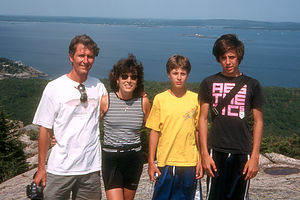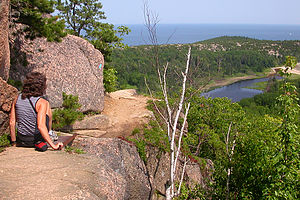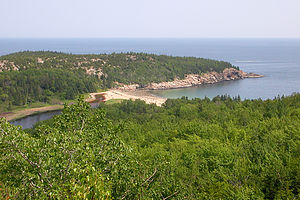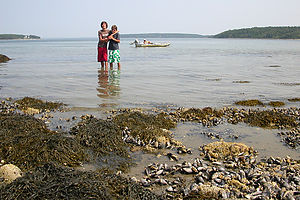- Home
- About
- Map
- Trips
- Bringing Boat West
- Migration West
- Solo Motorcycle Ride
- Final Family XC Trip
- Colorado Rockies
- Graduates' XC Trip
- Yosemite & Nevada
- Colorado & Utah
- Best of Utah
- Southern Loop
- Pacific Northwest
- Northern Loop
- Los Angeles to NYC
- East Coast Trips
- Martha's Vineyard
- 1 Week in Quebec
- Southeast Coast
- NH Backpacking
- Martha's Vineyard
- Canadian Maritimes
- Ocracoke Island
- Edisto Island
- First Landing '02
- Hunting Island '02
- Stowe in Winter
- Hunting Island '01
- Lake Placid
- Chesapeake
- Provincetown
- Hunting Island '00
- Acadia in Winter
- Boston Suburbs
- Niagara Falls
- First Landing '99
- Cape Hatteras
- West Coast Trips
- Burning Man
- Utah Off-Roading
- Maui
- Mojave 4WD Course
- Colorado River Rafting
- Bishop & Death Valley
- Kauai
- Yosemite Fall
- Utah Off-Road
- Lost Coast
- Yosemite Valley
- Arizona and New Mexico
- Pescadero & Capitola
- Bishop & Death Valley
- San Diego, Anza Borrego, Joshua Tree
- Carmel
- Death Valley in Fall
- Yosemite in the Fall
- Pacific Northwest
- Utah Off-Roading
- Southern CA Deserts
- Yosemite & Covid
- Lake Powell Covid
- Eastern Sierra & Covid
- Bishop & Death Valley
- Central & SE Oregon
- Mojave Road
- Eastern Sierra
- Trinity Alps
- Tuolumne Meadows
- Lake Powell Boating
- Eastern Sierra
- Yosemite Winter
- Hawaii
- 4WD Eastern Sierra
- 4WD Death Valley +
- Southern CA Deserts
- Christmas in Tahoe
- Yosemite & Pinnacles
- Totality
- Yosemite & Sierra
- Yosemite Christmas
- Yosemite, San Diego
- Yosemite & North CA
- Seattle to Sierra
- Southwest Deserts
- Yosemite & Sierra
- Pacific Northwest
- Yosemite & South CA
- Pacific Northwest
- Northern California
- Southern Alaska
- Vancouver Island
- International Trips
- Index
- Tips
- Books
- Photos/Videos
- Search
- Contact
Acadia National Park, ME
Sunday, July 11, 2004 - 3:30am by Lolo
150 miles and 3 hours from our last stop - 2 night stay
Travelogue
Acadia was not in our original itinerary for this trip, but when we saw that it was only 40 miles off of I95, we quickly changed our route and plans—Acadia is not the kind of place you want to just blow right by. Knowing how busy Bar Harbor can get in the summer, we made reservations for 2 nights at the Bar Harbor KOA (previously called Barcadia). The campground had a great location, just minutes outside the park, and right on Western Bay. Fortunately we were able to reserve one of the oceanfront sites—a bit pricey (about $50 a night), but well worth it. The views were marvelous, especially during low tide when the rocky shoreline and tidal pools were exposed.
 Family on SummitWe arrived quite early in the day, because of our decision to drive all the way to Augusta the previous night, so we had a whole day ahead of us to enjoy the park. Our first stop was the visitor center, where a knowledgeable ranger told us about a great hike with lots of rock scrambling, exposed cliffs, and spectacular views—the Beehive.
Family on SummitWe arrived quite early in the day, because of our decision to drive all the way to Augusta the previous night, so we had a whole day ahead of us to enjoy the park. Our first stop was the visitor center, where a knowledgeable ranger told us about a great hike with lots of rock scrambling, exposed cliffs, and spectacular views—the Beehive.
We headed out on the Park Loop Road to Sand Beach, which was near the trailhead for the Beehive hike. Before starting out on our trek up the mountain, which incidentally did look very much like a beehive, we headed down to check out the beach. It was quite crowded and there were even some very brave souls swimming in the frigid waters. Although it was quite nice, we all agreed that we liked the beach much better the last time we were here, but that was a very different situation. In the winter of 1999, as part of our first winter RVing experience, we camped in the Blackwoods Campground in the park, and the kids learned to cross country ski on the trails along this beautiful rocky coastline. Our memory of this beach from that trip is one of complete and total solitude with only our tracks disturbing its pristine snow.
 Hiking the Beehive TrailAlthough having Acadia to yourself in the winter is an unforgettable experience, there’s a lot to be said for summers here as well. The sun was out, the day was warm, and we were ready to take on the Beehive.
Hiking the Beehive TrailAlthough having Acadia to yourself in the winter is an unforgettable experience, there’s a lot to be said for summers here as well. The sun was out, the day was warm, and we were ready to take on the Beehive.
What a terrific hike!—however, not one for the acrophobic. It started off with some basic rock scrambling and gradually worked itself up to some pretty hairy sections where we had to grab onto metal handles fixed into the rock to climb up or traverse across exposed cliffs. I must confess to using more parts of my body than necessary to deal with some of the more difficult sections. In less than a half hour, we reached the 520 foot summit where the views of Sand Beach and the ocean beyond were stunning—well worth the palm sweating it took to get here.
Rather than retrace our steps, we decided to go down the back way along the Bowl Trail. Everything was going along just fine until I heard Andrew, who was hiking behind me, yell, “Mom, look out!” and heard the distinct sound of something rolling down the hill. For some unexplained reason, I didn’t turn around to see what was happening, but just froze in place—legs planted to the ground. The next thing I experienced was extreme pain as a boulder (or large rock as Andrew prefers to tell it) about the size of a basketball smashed into the back of my Achilles tendon. I saw stars. “Poor Andrew!” I thought. This wasn’t the first time he had taken me out with a rock on vacation (see Olympic National Park, 2001). He felt terrible. A rock on the trail had come loose when he stepped on it and zeroed in on me as its target. My ankle was already swelling up and turning colors by the time I limped back to the RV.
 View from the Beehive TrailAs we sat in the RV with ice on my ankle, we all wondered the same thing—What was this going to do to our trip? After all, we were only 2 days into a 3 ½ week adventure and our vacations are always centered around active stuff. What if something was seriously wrong with my foot? I was starting to feel pretty depressed. What if I couldn’t run anymore?
View from the Beehive TrailAs we sat in the RV with ice on my ankle, we all wondered the same thing—What was this going to do to our trip? After all, we were only 2 days into a 3 ½ week adventure and our vacations are always centered around active stuff. What if something was seriously wrong with my foot? I was starting to feel pretty depressed. What if I couldn’t run anymore?
Thinking that was the end of any more activity at least for that day, Herb suggested heading back to the campground. “Oh, no,” I said. It was going to take a lot more than this to stop me. I might not be able to walk, but I could still ride a bike. Not totally convinced that this was a wise idea, Herb continued on the Park Loop Road to Eagle Lake where we had been told about a nice bike ride. After a little struggle getting my sneaker over my now swollen ankle, I was able to bike the 6 miles of carriage roads around the lake without too much difficulty. It was very pretty and I felt much better knowing that my vacation wasn’t totally ruined.
That night back at the campground, Herb and I relaxed with a glass of wine on the rocks by the beach while the boys pedaled madly around the campground in little rental go-carts. To each his own. We waited for the sun to set over Western Bay before letting the bugs and the cool night air chase us inside. It really was an incredible location.
 Brotherly love during Western Bay boat tripThe next morning we arose early to start the process of inflating our 12-foot Avon inflatable raft, which we intended to use to explore Western Bay. This silly little raft, which when not being used lives in a big bag at the foot of the kid’s bed over the cab, has provided us with some of our most wonderful vacation experiences. With it, we have explored the Pictured Rocks along Lake Superior, cruised along Lake Powell and the Flaming Gorge Reservoir, rafted down the Snake and Colorado Rivers, and much more. It has definitely earned the space it takes up in the RV. To propel the raft, we bring along a 6 hp motor, which we attach to a support Herb built by the back ladder of the RV when not in use.
Brotherly love during Western Bay boat tripThe next morning we arose early to start the process of inflating our 12-foot Avon inflatable raft, which we intended to use to explore Western Bay. This silly little raft, which when not being used lives in a big bag at the foot of the kid’s bed over the cab, has provided us with some of our most wonderful vacation experiences. With it, we have explored the Pictured Rocks along Lake Superior, cruised along Lake Powell and the Flaming Gorge Reservoir, rafted down the Snake and Colorado Rivers, and much more. It has definitely earned the space it takes up in the RV. To propel the raft, we bring along a 6 hp motor, which we attach to a support Herb built by the back ladder of the RV when not in use.
As we putted out into the bay, there were a fair number of people watching us—I’m not sure if they thought we were nuts or whether they were just envious. Probably a little bit of both. We headed east under the bridge that connects Mount Desert Island with the mainland and found a secluded island to have lunch on. Just as we were commenting how great it was to have this whole island to ourselves, a group of about 10 kayaks rounded the corner and shouted, “Mind if we share?” Of course we minded, but what could we say? Pretending that we were just getting ready to leave anyway, we shoved off and found another secluded island. This time it was gnats rather than kayakers that chased us off.
We came across some local fisherman digging for mussels and clams in the sand now exposed by the receding tide. They warned us that if we didn’t go quickly, we wouldn’t have enough water to get back under the bridge to our campground and would have to wait for the tide to come back in. Heeding their advice, we quickly set off carefully looking over the sides for rocks. During our cruise back, we had the good fortune to follow a school of dolphins leaping playfully in the water.
The trip was quite relaxing and the scenery was beautiful, but I think that the boys would have had a much better time if they could have gone swimming. The water was just too darn cold. I tried to reassure them that the water would actually get warmer as we traveled north into Canada, but I don’t think they believed me. But it’s true. Because of the gulf stream, the waters of the Gulf of St. Lawrence are as warm as the waters off of Virginia and the Carolinas. I sure hope the guide books are right.
After dinner that evening, we bought a blueberry pie from a couple in an old VW Beetle that drove around the campground each night selling pies. It was absolutely the best pie we had ever had—practically overflowing with fresh Maine blueberries. I wish we had bought some more.
Description
Acadia National Park, located on the rugged coast of Maine, encompasses 45,000 acres of mountains, forests, lakes, and rocky coastline. Most of Acadia is on Mt. Desert (pronounced "dessert") Island, with some other bits of the park on small islands and the Schoodic peninsula. Although Acadia is the fifth smallest national park, its 4.2 million annual visitors make it the second most highly visited park in the country.
 Lolo on rocksMount Desert Island has been a popular destination since the mid-19th century when the town of Bar Harbor became a thriving summer resort community for the most prominent members of society. Families such as the Vanderbilt's, Rockefellers, Carnegies, and Astor's built elegant mansions, which they called "cottages," along its beautiful rocky coastline. For over 40 years, much of high society summered here until the Great Depression and World War II ended such extravagant living. The real end came to society life here when the Great Fire of 1947 destroyed numerous hotels and more than 70 mansions.
Lolo on rocksMount Desert Island has been a popular destination since the mid-19th century when the town of Bar Harbor became a thriving summer resort community for the most prominent members of society. Families such as the Vanderbilt's, Rockefellers, Carnegies, and Astor's built elegant mansions, which they called "cottages," along its beautiful rocky coastline. For over 40 years, much of high society summered here until the Great Depression and World War II ended such extravagant living. The real end came to society life here when the Great Fire of 1947 destroyed numerous hotels and more than 70 mansions.
Fortunately, the wealthy inhabitants of Bar Harbor loved the natural beauty around them and donated land, time, and money so that this land could be preserved for future generations to enjoy. Thanks to the untiring efforts of George B. Dorr, in 1919 Acadia became the first national park east of the Mississippi River. It was actually called Lafayette National Park at that time, but in 1929 the name was changed to Acadia.
 BeehiveThe 45 miles of carriage roads throughout the park were the gift of another summer resident and philanthropist, John D. Rockefeller, Jr. He loved the park and wanted to create a way for people to enjoy its beauty by horse and carriage, rather than by motorcar. Rockefeller, who had a gifted eye for landscape architecture, constructed the roads in such as way as to take best advantage of the park's beauty. Today these carriage roads are a wonderful way to explore the park, both on foot and by bike. Also, in the winter, they are ideal for cross-country skiing and snowshoeing.
BeehiveThe 45 miles of carriage roads throughout the park were the gift of another summer resident and philanthropist, John D. Rockefeller, Jr. He loved the park and wanted to create a way for people to enjoy its beauty by horse and carriage, rather than by motorcar. Rockefeller, who had a gifted eye for landscape architecture, constructed the roads in such as way as to take best advantage of the park's beauty. Today these carriage roads are a wonderful way to explore the park, both on foot and by bike. Also, in the winter, they are ideal for cross-country skiing and snowshoeing.
In addition to the carriage roads, there are over 120 miles of hiking trails, many of which have spectacular ocean and woodland views. Most of the hikes in the park are fairly short to moderate. One very exhilarating and scenic hike is the Beehive trail, which starts just north of the Sand Beach upper parking lot. The hike is not for those with a fear of heights, as it requires using a series of fixed metal handles to climb up steep trails and traverse across exposed cliffs. However, the stunning view of Sand Beach and the ocean beyond make the struggle worthwhile. It takes about 30 minutes to get to the 520 foot summit.
One of the longest trails in the park is the 7.4 mile (round trip) hike to the summit of Cadillac Mountain. The Cadillac Mountain South Ridge Trail starts just south of the entrance to the Blackwoods Campground, climbs through the woods for awhile, and then cuts above the treeline as it approaches the summit. The trail, which rises 1,340 feet in 3.7 miles, is fairly strenuous.
By car, the best way to see the major sights in the park is to drive the 27-mile Park Loop Road (which includes a 7-mile round trip up Cadillac Mountain). In summer time, the road becomes extremely crowded, so it pays to get an early start. The road is one-way in a clockwise direction, with the exception of a two-way portion near the start that allows direct access to the Cadillac Mountain Road. Some of the many interesting stops along the way include:
- Frenchman Bay Overlook - scenic views of the bay and Schoodic Peninsula
- Sand Beach - pretty beach made of crushed marine shells. Supervised swimming is available in the invigorating, chilly water.
- Thunder Hole - a narrow slot in the rocks along the coast named for the roaring sound produced when trapped air is squeezed out of a chasm by the incoming surf
- Otter Point - tidal pools to explore (an hour or two before low tide)
- Wildwood Stables - wagon rides on the carriage roads
- Jordon Pond House - meals and traditional tea on lawn
- Cadillac Mountain - 3.5 mile switchback road to the summit, which is the highest point on the eastern seaboard north of Brazil
There are two campgrounds within the park boundaries--Blackwoods, which is open all year round, and Seawall, which is only open in the summer. Although there are not many facilities in the park, there are numerous restaurants, shops, hotels, campgrounds, etc., in the nearby resort community of Bar Harbor.
- ‹ previous
- 2 of 23
- next ›
Acadia National Park location map in "high definition"
Javascript is required to view this map.

Enjoyed your journal of this part of your travels. Maine's indeed a great place to visit and it's apparent that you recognize and enjoy the best life has to offer; the journey.